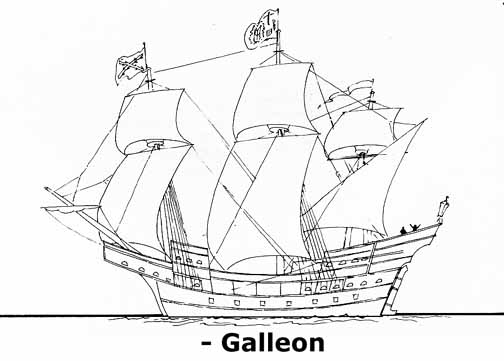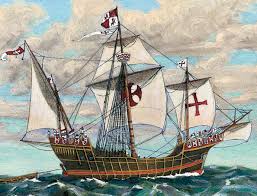
 PEDRO'S JOURNAL
PEDRO'S JOURNAL
BY PAM CONRAD

Come travel along with a young cabin boy, who just happened to keep a diary while sailing on the Santa Maria during Christopher Columbus’ first voyage to the New World in 1492.
|

Pedro's Journal by Pam Conrad
The tale of Pedro de Salcedo, a ship's boy aboard the Santa
Maria, who accompanies Christopher Columbus on the journey
to find the new world is told in this book. Pedro's story is
told in journal entries about the trip across the Atlantic and
the exploration of the Indies. Pedro sees Columbus as
egotistical and hot-tempered. He describes the native people
as peaceful and unfairly terrorized by the Spanish. This book
is appealing for reluctant readers because the characters,
historical details, and plot are written in simple language.
Before Reading:
Explain to students that Pedro's Journal is a story of Christopher Columbus's first
voyage, told through the fictional journal of Pedro, a ship's boy. Tell them that
journals are an important source of information about the voyages of explorers like
Columbus.
Ask students to imagine how they would feel if they were the only young crew
members of a space journey to Mars, where no one has ever gone. The captain and
other experts would know the route and plans, but the young crew members would
just have to trust the leaders to get them there. They would have to learn their
tasks, and at first everything about life aboard a spaceship would seem strange.
Encourage students to talk about how they might feel on the day of liftoff. How might
their feelings change as the days went by? Suggest that they try to identify with
Pedro's feelings as he says goodbye to the world he knows, and his ship sets out into
the unknown.
Explain that because this is Pedro's journal, each entry is identified by a date. Tell
students that Pedro's sketches give information that helps to understand his journal
entries. For example, the banners on page 1 represent the identifying flags flown by
each ship, the Niña, the Pinta, and the Santa María.
During Reading:
Ask students to listen as you read pages 1–12 aloud. When you have finished reading,
ask the children to identify Pedro's feelings about the voyage. Discuss how his
responses compare with their own feelings about a space voyage.
Make a big chart on a bulletin board with the following categories:
• Observations
• Questions
• Fact
• Fiction
While reading, ask students to jot down interesting observations from the story onto
sticky notes. Place the sticky notes under the observation category. Ask students to
2
formulate a question for each observation they make and then do research to
determine whether the observation is fact or fiction and why.
Literary Concepts:
Discuss setting: Display a globe or a map of the world. Locate Spain and place colored
pins or stickers near Palos, in the Canary Islands, and in India. Stretch a piece of
string or yarn from the Canary Islands to the West Indies.
Explain to students that a famous traveler, Marco Polo, had traveled overland from
Italy to India and China in the 1200s, and had brought back gold, silk fabrics, and
spices the Europeans had never seen before. Marco Polo told of lands to the east that
had great riches—the Indies, China, and Japan. Show students on the map or globe how
Italian merchants could travel east, by sea and then by land, to India and China. Tell
them that merchants did travel Marco's route, traded with the eastern lands, and
made huge fortunes; but overland travel was long, costly, and dangerous. Then explain
that people believed they could acquire these riches more quickly and in greater
abundance if they could find a sea route to the Indies. Some brave navigators tried to
go around Africa. (Use map or globe to illustrate.) But Columbus had a different idea.
Point out that most educated people of Columbus's time had begun to believe that the
earth was a sphere. So Columbus believed he could get to the Indies by sailing west.
Ask students whether Columbus had a realistic idea or not. (In theory, it was possible.
What Columbus did not know was that there were whole continents, North and South
America, between Spain and the Indies.) Explain that the sailors were fearful because
they could not understand the concept of sailing west to get to the Indies, or eastern
lands. Some believed that there were monsters and other dangers in the unknown seas,
or even that the earth was flat and they might sail right off the edge.
Ask students to predict what might happen if and when the ships eventually do reach
land. How do they think Columbus, who expects to find the wealth of the Indies, will
react to what he does find? And how will his sailors feel?
Points to Ponder:
• What qualities does Pedro have that will help him on this voyage?
• What are the crew's feelings about the voyage? How do you know?
• Describe life on shipboard, including the sounds and physical feelings.
• Although she is not present, Pedro's mother is an important figure in his life. He
has already spoken of her more than once. What part do you think she has in
this story?
Exploring Genre:
This book is a good example of the genre Historical Fiction. Set in the period of 1492-
1493 during the actual voyage of Columbus to the New World, it weaves a fictional
story around historical fact and research. The author's note at the end of the book
acts as a disclaimer for absolute accuracy, as her purpose was to create fiction, but
the book can serve as an excellent vehicle for exploring facts from the time period.
3
A Sea of Words
This book contains many nautical terms. Be a word detective and make a list of the
nautical words used to describe and name ship parts and crew. Try to determine what
the word means from the context of the story. If you don't know what the word
means, check it out in a dictionary. Use your list of words to create a word search or
crossword puzzle. Here are a few to start with: captain, dock, fleet, ship's boy, dinghy.
The Pedro Times:
Imagine that you are Pedro de Salcedo just returned from your seven month voyage.
Write an article for the local newspaper, giving a first hand account of some of your
adventures. Include a drawing or two of the strange things you saw on the voyage to
the New World.
A Different Point of View:
Imagine that you are one of the native people that Columbus meets on the islands.
Write an account of how the native person would view Columbus and his men and ships.
Use information from the book to support the native point of view.
21st Century Explorers:
What are the new worlds left to be explored today? Columbus sailed, at great risk,
into the unknown to find fame and fortune. If Columbus lived today, what might he be
doing? Ask your students, if given the chance to be "Ship's Boy" on an exploration into
space, would they go? Why or why not?
Models:
Build a model of one of Columbus's sailing ships or make a drawing of one. Do some
research to find out the actual size and dimensions of the ship.
Reading Extensions:
Read Jane Yolen's Encounter, a fictionalized account of Columbus's meeting with the
Tanio people, written from the perspective of a Tanio child. Or your students may read
Morning Girl by Michael Dorris, which deals with the Taino people immediately before
Columbus lands on their island. Used together, Pedro's Journal, Morning Girl, and
Encounter may raise questions about the treatment of indigenous people and how their
lives were changed following their "discovery." Explore some of the questions and
issues of explora

Wow, thank you for sharing your efforts!!!
ReplyDeleteMay God bless and guide you on your home school journey.